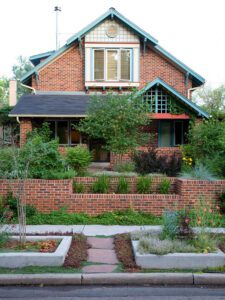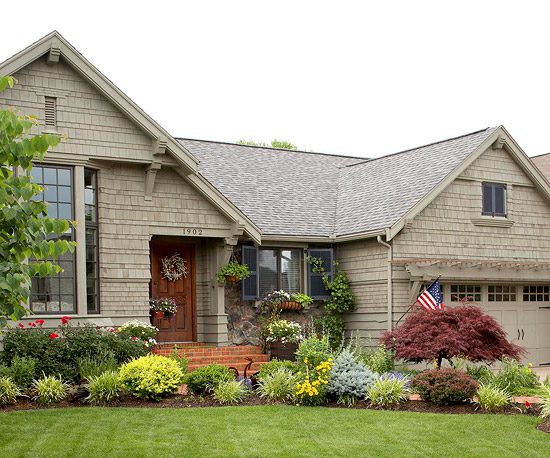Make your yard the envy of neighbors and passersby with these tips to landscape for curb appeal.
Nearly every homeowner wants to landscape for curb appeal. Maximizing your yard’s attributes and minimizing its problems to create a beautiful streetside view doesn’t have to be difficult, daunting, or expensive. No matter your style or plant preferences, here are eight ideas to transform your front yard into a beautiful, attractive space.
 Consider the house. Lots of people look at the size of the lawn or the shape and slope of the front yard, but many people forget a critical consideration in landscaping for curb appeal.
Consider the house. Lots of people look at the size of the lawn or the shape and slope of the front yard, but many people forget a critical consideration in landscaping for curb appeal.
“Rule No. 1, and the one that I see ignored a lot, is that — far and away — the most enormous thing in the garden is your house,” says Leslie Land, author of The New York Times 1,000 Gardening Questions & Answers and blogger at leslieland.com. “You have this enormous design limitation, and you need to design for curb appeal based on the size and shape of your house and how it relates to the street.”
Get more ideas from your house.
Work with masses and shapes to create a landscape for curb appeal. A corollary to recognizing the size of the house is massing and shape, Land says. “If your house is big and you want to plant lots of little pretty flowers, they don’t read from the street,” she says. Instead, use plants and repetition — midsize shrubs to line a path, for example, or a row of shrubs — that are inspired by and complement the shape and size of the house. “People won’t see individual flowers driving by,” Land says. They will see the impact of a plant grouping that reflects the shape and lines of the house and walkways.
Consider evergreens.
Use secondary hardscape elements to help design a landscape for curb appeal. A deep sidewalk, for example, offers an opportunity for a wider flowerbed as accent. A bench provides a place for a gathering of shrubs and perennials. Think about what’s there (or what could be added) and how to spotlight it.
Emphasize the rite of passage. Landscaping for curb appeal is ultimately about moving to the front door in a pleasing way. “You have to always be mindful of the experience of passage from the street to the door,” Land says. “Think about what kinds of transitions are available and whether there is a way to break up the trip without destroying the necessity of people seeing very clearly where to go.” That may include a bend in a walkway (with the doorway still in sight) or urns on either side of a curve, Land suggests.
Turn to the color wheel. The color of your house should be a consideration in choosing plants to landscape for curb appeal. For example, a blue house feels calm and collected accented by a collection of purple, pink, yellow, and white flowers. Red trim will pop with flowers in orange, bright yellow, and red. “The house really will dominate everything, and if the garden doesn’t go with it, it might be because of color,” Land says. Learn more about using the color wheel in the garden.
Include big things where appropriate. Most of the time, people see your house — and judge its curb appeal — quickly, either on a walk or drive by. So large shapes and masses that are attractive from a distance should be a part of a landscape with curb appeal. That doesn’t mean blocking windows or doors or the facade of the house with plants that will get too large. “The thing you want to be appealing is the house itself,” Land says.
Keep it low-maintenance. Even if you love gardening and all its associated tasks, if you one day plan to sell your house, an elaborate garden can be considered a negative by a potential buyer. “Things that require a lot of maintenance may appeal to you, but for curb appeal, people don’t want to imagine themselves spending hours deadheading,” Land says. Keep it clean: petunias that won’t litter petals everywhere, for example, and shrubs that don’t require a lot of tender loving care. “In beautiful landscapes you see in magazines, there isn’t a stray leaf or twig, but when you come home, things are different,” Land says. Gather low-maintenance ideas.
Think through the seasons. A landscape that goes dormant in the winter will look foreboding and uninviting. A landscape with curb appeal includes structural elements such as trees and shrubs, as well as materials that look good in spring, summer, autumn, and winter.
Source: Article contributed by Better Homes & Gardens by Kelly Roberson
